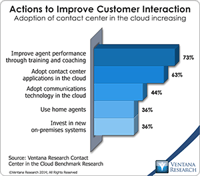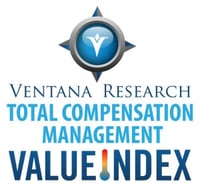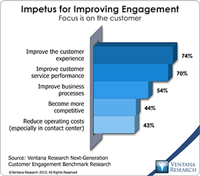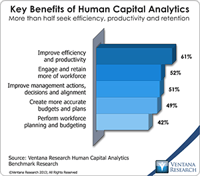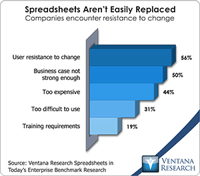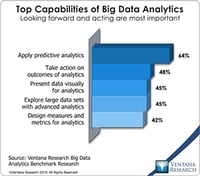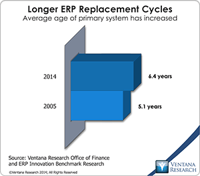Recently NewVoiceMedia announced that it has raised $50 million to fund its growth. The company was founded in 2000 in the U.K., initially offering call management and routing as cloud-based systems. Until then, most companies built their contact centers using on-premises private branch exchange (PBX) or automated call distributor (ACD) call management systems, with on-premises call routing and business applications such as customer relationship management (CRM). Some companies offered...
Read More
Topics:
Customer Analytics,
Customer Experience,
Voice of the Customer,
Cloud Computing,
Customer & Contact Center,
Customer Service,
Call Center,
Contact Center,
Contact Center Analytics,
CRM
Now available from Ventana Research is our Value Index on Total Compensation Management for 2014. Total compensation management directly addresses one of an organization’s largest investments – employee pay. As such it is a critical activity for supporting other human capital management and talent management processes.
Read More
Topics:
SAP,
Human Capital Management,
Kenexa,
Peoplefluent,
SuccessFactors,
Decusoft,
Towers Watson,
Analytics,
Business Analytics,
Business Collaboration,
Cloud Computing,
Financial Performance,
IBM,
Mobility,
Oracle,
Workforce Performance,
Compensation,
SumTotal Systems,
TCM,
Value Index,
beqom,
Pay for Performance
Oracle has a large and diverse set of products and now has most of its business applications operating in the private and public cloud. However, some recent acquisitions have enabled it to focus on cloud-based-products for managing the customer experience. Our next generation customer engagement research has found that customer experience is the top impetus for improving customer engagement as found by almost three quarters (74%) of organizations. Oracle has created a customer experience suite...
Read More
Topics:
Sales Performance,
Social Media,
Customer Analytics,
Customer Experience,
Social CRM,
Mobile Apps,
Operational Performance,
Analytics,
Business Analytics,
Cloud Computing,
Collaboration,
Customer & Contact Center,
Customer Service,
Call Center,
Contact Center,
Contact Center Analytics,
CRM
In the past year Workday has been making efforts to improve its human capital management (HCM) suite focused directly on the core human resources management systems and talent management software. In my previous analyst perspective about Workday I looked at its mobile capabilities for HCM. These additions, in concert with the enhancements discussed here, offer useful improvements. I have also noticed changes in the HCM market that impact all large competitors in it, including Workday. Before...
Read More
Topics:
Big Data,
Mobile,
Social Media,
HCM,
Recruiting,
Operational Performance,
Analytics,
Business Analytics,
Business Collaboration,
Business Intelligence,
Cloud Computing,
Customer & Contact Center,
Workforce Performance,
Workday,
HR/Payroll
One of the charitable causes to which I devote time puts on an annual vintage car show. The Concours d’Élegance dates back to 17th century France, when wealthy aristocrats gathered with judges on a field to determine who had the best carriages and the most beautiful horsepower. Our event serves as the centerpiece of a broader mission to raise money for several charitable organizations. One of my roles is to keep track of the cars entered in the show, and in that capacity I designed an online...
Read More
Topics:
Planning,
Sales Performance,
Supply Chain Performance,
Office of Finance,
Reporting,
Self-service,
Budgeting,
dashboard,
Operational Performance,
Analytics,
Business Analytics,
Business Intelligence,
Business Performance,
Customer & Contact Center,
Financial Performance,
Information Applications,
Workforce Performance,
Data,
Financial Performance Management,
Microsoft Excel,
Spreadsheets
Our benchmark research consistently shows that business analytics is the most significant technology trend in business today and acquiring effective predictive analytics is organizations’ top priority for analytics. It enables them to look forward rather than backward and, participate organizations reported, leads to competitive advantage and operational efficiencies.
Read More
Topics:
Big Data,
Predictive Analytics,
Sales Performance,
Statistics,
IT Performance,
Operational Performance,
Analytics,
Business Analytics,
Business Collaboration,
Business Intelligence,
Business Performance,
Cloud Computing,
Customer & Contact Center,
Data Integration,
Financial Performance,
Governance, Risk & Compliance (GRC),
Information Applications,
Information Management,
Location Intelligence,
Operational Intelligence,
Workforce Performance
Like other vendors of cloud-based ERP software, NetSuite offers the key benefits of software as a service (SaaS): a smaller upfront investment, faster time to value and potentially lower operating costs. Beyond that NetSuite’s essential point of competitive differentiation from is broad functionality beyond financial management, including capabilities for customer relationship management (CRM), professional services automation (PSA) and human capital management (HCM). These components make it...
Read More
Topics:
Microsoft,
Mobile,
SaaS,
Sales,
Social Media,
Customer Experience,
ERP,
HCM,
Human Capital,
Office of Finance,
communications,
Dynamics AX,
Dynamics GP,
Dynamics NAV Dynamics SL,
PSA,
Sage Software,
UI,
Unit4,
Analytics,
Business Analytics,
Business Collaboration,
Business Performance,
Cloud Computing,
Financial Performance,
Workforce Performance,
CFO,
CRM,
FinancialForce,
HR,
Infor,
Social,
Financial Performance Management,
FPM,
Plex,
Professional Services Automation,
Workday Collaboration
